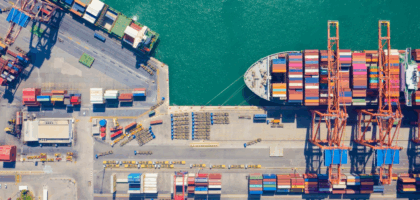The internet can be your best friend when you’re thrown a word or phrase from the logistics world that you just don’t quite understand. A quick search and voila! Now you know what a “BOL” is. Wouldn’t it be nice though if these things were just simply spelled out for you? Don’t worry…we’ve got your back.
Here are some of the most common words, acronyms, and phrases you may hear when talking with your freight forwarder.
A
- Accessorial Charges – Sometimes called “additional charges,” these are expenses made for performing services beyond normal pickup and delivery, such as a liftgate or inside delivery.
- Air Waybill (AWB) – A document that accompanies goods on both domestic and international flights to a specific destination. Also known as an air consignment note, an AWB is a type of bill of lading and is a non-negotiable instrument of air transport which serves as a receipt for the shipper, indicating the carrier has accepted the goods listed therein and obligates itself to carry the consignment to the airport of destination according to specified conditions.
- All Risk – A type of marine insurance that is the broadest kind of standard coverage but excludes damage caused by war, strikes, and riots.
- Arrival Notice – A document issued by freight forwarders to consignees advising them of their shipment’s arrival.
B
- BAF – An acronym for Bunker Adjustment Factor, this is an adjustment in shipping charges to offset price fluctuations in the cost of bunker fuel.
- Bill of Lading (BOL) – A contract between the owner of the goods and the carrier. There are two types: a straight bill of lading is non-negotiable. A negotiable, or shipper’s order bill of lading, can be bought, sold, or traded while goods are in transit and is used for many types of financing transactions. The customer usually needs the original, or a copy, as proof of ownership to take possession of the goods.
- Bonded Carrier – A carrier licensed by U.S. Customs to carry customs-controlled merchandise between customs points.
- Bonded Shipment – A shipment of goods in bond, as in when a shipment travels within the country of import before payment of the required duties and taxes.
C
- Cargo Claim – A demand made upon a transportation company for payment due to freight damage or loss alleged to have occurred while the shipment was in possession of the carrier. Learn more about claims and the claims process here
- Carnet – A customs document permitting the holder to carry or send merchandise temporarily into certain foreign countries for display, demonstration, or other purposes without paying import duties or posting bonds.
- CBP – An acronym for Customs and Border Protection, the CBP is the largest federal law enforcement agency of the U.S. Department of Homeland Security and is the country’s primary border control organization. The CBP is responsible for regulating and facilitating international trade, collecting import duties, and enforcing U.S. regulations, including trade, customs, and immigration.
- Certificate of Origin – A document certifying the country of origin of goods. This is normally issued or signed by a Chamber of Commerce or Embassy.
- Commercial Invoice – A bill for the goods from the seller to the buyer. These invoices are often used by governments to determine the true value of goods for the assessment of customs duties and are also used to prepare consular documentation.
- Commodity – Refers to the goods being shipped. These could be any article of commerce.
- Consignee – The person or firm named in a freight contract to whom the goods have been cosigned or turned over.
- Customs Broker – An individual or company licensed by the government to enter and clear goods through Customs.
- Customs Clearance – The procedures involved in getting cargo released by Customs through designated formalities, such as presenting an import license or permit, payment of import duties, and other required documentation.
- Customs Invoice – A document required by some foreign countries’ customs officials to verify the value, quantity, and nature of the shipment, describing the shipment of goods and showing information, such as the consignor, consignee, and value of the shipment.
D
- Dangerous Goods – Classified by IATA, these are hazardous materials or substances that can pose an unreasonable risk to health, safety, and property when transported in commerce.
- Delivery Receipt – Document dated and signed by the consignee or its agent at the time of delivery stating the condition of the goods upon arrival. The signed delivery receipt is returned to the driver for retention at the terminal and the customer retains the remaining copy.
- Demurrage – The excess time that it takes for loading or unloading a vessel, thus causing a delay of scheduled departure. This only refers to situations in which the charter or shipper is at fault—not the vessel’s operator. It is also charged to containers under the following conditions where there is no delay in the vessel schedule: after discharge of an import container, after the expiration of free time, and before the container is recovered from the port. For export containers, the charges would apply after the in-gate of the full load, after the expiration of free time, and before the container is loaded on the outbound vessel.
- DOT – An acronym for Department of Transportation, this government organization oversees federal highway, air, railroad, maritime, and other transportation administration functions.
- Drayage – Shipping goods a short distance via ground freight. This can be the hauling of a load by cart with detachable sides (dray) or road transportation between the nearest railway terminal and the stuffing location.
- Duty – A tax imposed on imports by the Customs authority of a country. Duties are generally based on the value of the goods. Some other factors such as weight or quantity (specific duties) or a combination of value and other factors (compound duties) can also occur.
E
- EDI – Also known as Electronic Data Interchange for Administration, Commerce, and Transportation, this is an international syntax used in the interchange of electronic data.
- ETA – Estimated Time of Arrival.
- ETD – Estimated Time of Departure.
- Exception – Any delivery in which the receiver or driver notes a problem on the delivery receipt before signing it. Typically, exceptions concern damage and shortages.
F
- FCL – An acronym for Full Container Load, this is a standard 20 or 40 ft. length container that is stuffed/loaded and unstuffed/unloaded under the risk and account of one shipper and only one consignee or destination.
- FMC – Also known as the Federal Maritime Commission, this independent federal agency is responsible for the regulation of all ocean-borne international transportation of the United States.
- FEU – Short for Forty-Foot Equivalent Unit, this is a measure of a ship’s cargo-carrying capacity. One FEU measures forty feet by eight feet by eight feet—the dimensions of a standard forty-foot container. An FEU equals two TEUs.
G
- GVW – Also known as Gross Vehicle Weight, this is the combined weight of the vehicle (tractor and trailers) plus its cargo.
H
- HAWB – Referred to a lot in this industry, a HAWB—or House Airway Bill—is issued by the airfreight agent (normally the freight forwarder) for its customer and serves as the receipt for the goods or the shipment, and as evidence of a contract between the airfreight agent and the customer.
I
- IATA – The International Air Transport Association (IATA) is a trade association serving airlines, passengers, shippers, travel agents, and governments. Their goal is to promote safety, standardization in forms, and aid in establishing international airfares.
- Import Certificate – A means by which the government of the country of ultimate destination exercises legal control over the internal channeling of the commodities covered by the document.
- Import License – Also referred to as an “import permit,” this is a document required and issued by some national governments authorizing the importation of goods.
- Incoterms – Maintained by the International Chamber of Commerce (ICC), this is a codification of terms used in foreign trade contracts to define which parties incur the costs and at what specific point the costs are incurred. Learn more about Incoterms here
- ISF – Standing for Import Security Filing, and commonly known as 10+2, this is a Customs Border and Protection (CBP) requirement for all ocean cargo imports into the United States. The filing documents importing information and details as shipments move from point to point. It must be delivered to CBP at least 24 hours before the vessel carrying the shipment is due to make their final departure to the U.S.
- ITAR – An acronym for International Trafficking in Arms Regulations, this refers to the regulations promulgated and implemented by the Department of State that control the export of articles, services, and related technical data that are inherently military in nature. Learn more about ITAR here
L
- LCL – Also known as Less-Than Container Load, this describes the shipment of goods with less volume than a standard full container.
- Letter of Credit – A financial document issued by a bank at the request of the consignee guaranteeing payment to the shipper for cargo if certain terms and conditions are fulfilled. Normally, it contains a brief description of the goods, documents required, shipping date, and expiration date after which payment will no longer be made.
- LTL – Abbreviated for Less-Than-Truckload, this is a quantity of freight less than that required for the application of a full truckload. The historical definition for LTL freight is shipments under 10,000 pounds. However, competition from other freight carriers restricts shipments for most LTL carriers to range between 300 and 3,000 pounds.
M
- Manifest – The list of goods or passengers on a vessel or aircraft.
- MAWB – Another term you will hear a lot in this industry, as MAWB—or Master Airway Bill—is the main document issued by the airline that is carrying the shipment (or by its authorized agent). This document is non-negotiable, and it provides for transport of goods or consignment from one airport to another.
- Multimodal Transportation – Also called “intermodal,” this is the movement of freight involving more than one mode of transportation (ground, air, rail, ocean).
N
- NVOCC – Short for Non-Vessel Operating Common Carrier, this is a type of ocean freight forwarder. NVOCCs book space in large quantities for a reduced rate, then sell space to shippers in lesser amounts. They also consolidate smaller shipments into a container load that ships under one bill of lading.
O
- O/H – Stands for Over Height. This is a container with cargo that exceeds the height of the container.
- O/S – Stands for Open Sided. This is a container with open sides for over width cargo.
- O/T – Stands for Open Top. This is a container with open top loading facility and a tarpaulin roof that is suitable for the carriage of heavy, over height cargo.
- O/W – Stands for Open Width. This is a container with goods protruding beyond the sides of the container/flat rack onto which they are packed.
- OOG – An acronym for Out of Gauge, these are goods whose dimensions exceed those of the container in which they are packed.
P
- POD – A Proof of Delivery (POD) is a cargo/package receipt with the signature of the recipient who accepted the freight.
- Packing List – A shipping document issued by the shipper to the carrier, customs, and the consignee serving the purposes of identifying detailed information of, but not limited to, the package count, product count, measurement of each package, and weight of each package.
- Power of Attorney – A legal document authorizing the filing of customs documents on behalf of a company by a customs broker or freight forwarder.
- Proforma Invoice – An invoice provided by a supplier prior to the shipment of merchandise, informing the buyer of the kinds and quantities of goods to be sent, their value, and important specifications (weight, size, and similar characteristics).
- Project Cargo – This is a term used normally when it comes to shipping air or ocean cargo that does not fall within standard methods and requires special equipment or handling (i.e. over height, oversized cargo).
R
- Reefer – A refrigerated container.
- RORO – An abbreviation for Roll-On/Roll-Off, this is a type of ship designed to load and discharge cargo which rolls on wheels or tracks.
S
- Shipping Weight – Represents the gross weight in kilograms of shipments, including the weight of moisture content, wrappings, crates boxes, and containers.
- Shortage – This term is used when the number of unites received is less than the quantity shown on the shipping documents.
- SOLAS – Also known as Safety of Life at Sea (SOLAS), this international convention describes the requirement for all merchant ships of any flag state to comply with the minimum safety norms laid down in the chapters set forth by the International Maritime Organization (IMO).
T
- Tariff – A document setting forth applicable rules, rates, and charges for the movement of goods. A tariff sets forth a contract of carriage for the shipper, consignee, and carrier.
- Through Bill of Lading – A single bill of lading covering receipt of the cargo at the point of origin for delivery to the ultimate consignee, using two or more modes of transportation.
- Transshipment – Refers to the act of sending an exported product through an intermediate country before routing it to the country intended to be its final destination.
- TL – Short for Truckload, this is a large-volume shipment from a single customer that weighs over 10,000 pounds or takes up the entire trailer space so no other shipment can be loaded.
- TEU – A Twenty-Foot Equivalent Unit (TEU) is a measure of a ship’s cargo-carrying capacity. One TEU measures twenty feet by eight feet by eight feet—the dimensions of a standard twenty-foot container. Two TEUs equal one FEU.
U
- ULD – An abbreviation for Unit Load Device, this is either an aircraft pallet and pallet net combination, or an aircraft container. A ULD must be structurally capable of restraining the loads and providing adequate protection to the aircraft systems and structure during flight.
- UN Number – An internationally accepted 4-digit number used to identify hazardous material.



